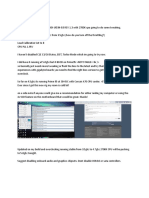LGA1155 Over Clocking Glossary
LGA1155 Over Clocking Glossary
Uploaded by
Kunal KumarCopyright:
Available Formats
LGA1155 Over Clocking Glossary
LGA1155 Over Clocking Glossary
Uploaded by
Kunal KumarCopyright
Available Formats
Share this document
Did you find this document useful?
Is this content inappropriate?
Copyright:
Available Formats
LGA1155 Over Clocking Glossary
LGA1155 Over Clocking Glossary
Uploaded by
Kunal KumarCopyright:
Available Formats
LGA1155 Overclocking Glossary
CPU Ratio: This is your main, and largely only, means of adding extra CPU frequency. Because the Base Clock is 100MHz by default, it's easy to calculate that a 45x multiplier will give you a 4.5GHz (or 4,500MHz) CPU. Memory Multiplier: This goes up to 21.33x on most overclocking-friendly boards, giving a maximum DDR3 memory frequency of 2,133MHz. However, this is only for P67 motherboards. Intel limits the memory multiplier to a basic 13.33x on H67 motherboards, as they're not designed for CPU overclocking. CPU Base Clock Since Intel choose to use just one clockgen on Sandy Bridge hardware (apparently due to the way the internal CPU ring bus memory controller needs to stay in sync - see What's New in Intel's Sandy Bridge for more on this), this value has a maximum adjustment of under 10MHz, or just 10 per cent. As such, much more acute 10KHz (0.1MHz) adjustments have been added by all major motherboard manufacturers to allow some changes. Matched with voltage changes listed below, you should be able to increase the base clock to 105MHz on all CPUs, and we've found a few will go as far as 107MHz, if you go nuts with the voltages. While a Base Clock as high as 107.8MHz might unlock 2,300MHz memory speeds, the extra voltage (and motherboard stress) generally isn't worth it for an everyday overclock. The bottom line with the Base Clock is that generally you don't have to touch it. CPU Voltage: Obviously this is the daddy that really gives you the MHz. However, remember that LGA1155 Sandy Bridge CPUs are made with a 32nm manufacturing process, so don't need as much juice as your last 45nm, 65nm or older CPU did. Up to 1.3V is completely fine for an everyday overclock, whereas at some way between 1.3V and 1.4V you'll see the heat output increase quite notably even if you can push the CPU a little bit higher. We wouldn't recommend using more than 1.3V unless you have a powerful cooler, and using a vcore of 1.4V or more isn't advisable unless you're just planning a quick Kamikaze benchmark run. Professional overclockers might use a vcore of 1.5V or above even, but bear in mind that these guys and gals get CPUs by the tray load from sponsors!
Click to enlarge
VCC/VCCIO/CPUIO: Vcc is the voltage at the IO (Input/Output) terminals to the CPU. Generally at 4GHz or under this doesn't need to be adjusted, but at 4.5GHz it can require a small bump to between 1.15V and 1.2V, depending on the quality of your CPU. Using over 1.2V should only be necessary if you're pushing the CPU toward 5GHz or more. Equally, if you're using the maximum memory multiplier, you will likely require about 1.25V here. Using over 1.4V is not recommended at all - you have been warned! VCCSA: The 'System Agent' is a facilitator unit in the CPU itself, and its Vcc (essnetially, voltage') is related to the Vcc IO above. It's default voltage is under 1V. The same rules apply here as above thugh, the only difference is if you're testing how far the Base Clock will go, then as much as 1.3V, or even 1.35V will be needed, but that's only recommend for benchmarking with appropriately strong cooling and not long term use. using over 1.4V is not recommended at all.
Memory Voltage: As with LGA1366 and LGA1156 CPUs, keep this value to within 0.5V of the VCCIO voltage to prevent long term damage to the CPU. By default, this is 1.1V, which means the 1.65V used by previous Intel DDR3 memory is still acceptable. However, more recent memory will be rated at 1.5V (or even 1.35V if you choose a low-voltage kit). Increasing the VCCIO voltage obviously gives you more overhead on your memory voltage (remember, add +0.5V at most or risk damaging your CPU). Intel Extreme Memory Profile (XMP): XMP is a safe memory overclock profile that's saved on the memory modules themselves. Beware that some motherboards might not handle the XMP settings of older DIMMs designed for LGA1156 systems. If you are carrying over an old set of memory, save your BIOS settings before using XMP and then check the voltages that are automatically applied. On kits designed for LGA1155 P67 or H67 motherboards, XMP is best turned on to get the most out of the shiny new memory you've just purchased. However, check if the XMP profile forces a change on the VCCIO and VCCSA that might affect your CPU overclock before saving and trying to boot Windows. Load-Line Calibration: As the CPU accepts more work, its power draw increases. This in turn causes a voltage drop (vdrop), which is automatically compensated by the motherboard by increasing the applied voltage slightly. Some motherboards might therefore call this option Vdrop, or even more inaccurately, vdroop. Normally LoadLine Calibration is an enable or disable setting. When overclocking, you always want to enable Load-Line Calibration. Some motherboards provide more advanced options, which we'll detail in turn. CPU PLL Voltage: Generally this doesn't need changing at all, although if increasing the CPU Voltage or the two Vcc options doesn't work, it's worth a try. Using anything over 2V isn't recommended, but 1.9V can help to stabilise an overclock. PCH Voltage: Translated, this means the chipset, as PCH standd for Platform Control Hub. Again, this shouldn't need a voltage change, but if all else fails on the other settings above try increasing it just a touch. Don't go crazy though, as most P67 chipset heatsinks are largely for show because the chip doesn't need much cooling at default speeds and voltages. DDR VRef (reference voltage): Don't bother touching it, leave it on Auto unless you have particularly special DDR3 that requires a specific voltage. Spread Spectrum : Spread Spectrum is useful in offices full of PCs, as it fluctuates the Base Clock frequency to prevent the PCs producing a sympathetic EMI field that might interfere with other devices. As such. you should disable Spread Spectrum when overclocking. However, Asus has a special, separate 'Spectrum Spread' function for its digital VRM hardware that should actually be left enabled to improve performance by reducing EMI. Asus assures us it does not affect the power provision due to its design.
You might also like
- Calypto's Latency GuideDocument2 pagesCalypto's Latency GuideFakeHack34100% (1)
- Calypto's Latency GuideDocument2 pagesCalypto's Latency GuideanoxmuosNo ratings yet
- Kawpow TuningDocument4 pagesKawpow TuningMark Indra WannNo ratings yet
- Intel Q9550 Core 2 Quad Basic Overclocking GuideDocument10 pagesIntel Q9550 Core 2 Quad Basic Overclocking GuidereeawsNo ratings yet
- ROG Overclocking Guide Core For 5960X, 5930K & 5280KDocument7 pagesROG Overclocking Guide Core For 5960X, 5930K & 5280KEzequiel77xNo ratings yet
- P67 Sandy Bridge Over Clocking GuideDocument44 pagesP67 Sandy Bridge Over Clocking GuideBandit_46No ratings yet
- UntitledDocument9 pagesUntitledgcatrinelNo ratings yet
- The Golden Rule of OverClocking IDocument7 pagesThe Golden Rule of OverClocking IgcatrinelNo ratings yet
- Guide: Overclocking FX-8350 To 4.8GHz On Crosshair V Formula-ZDocument7 pagesGuide: Overclocking FX-8350 To 4.8GHz On Crosshair V Formula-ZBobapatatasNo ratings yet
- Overclocking & PerformanceDocument4 pagesOverclocking & PerformanceTony WilliamsNo ratings yet
- Ti KPE OC GuideDocument30 pagesTi KPE OC GuideMathe ZsoltNo ratings yet
- Autolykos TuningDocument4 pagesAutolykos TuningIULIAN-ANDREAS-SERGIU MOLOIUNo ratings yet
- Clocking Corner: Crank ItDocument3 pagesClocking Corner: Crank ItTony WilliamsNo ratings yet
- Gigabyte AMD A75 Overclocking GuideDocument8 pagesGigabyte AMD A75 Overclocking GuideGIGABYTE UKNo ratings yet
- Configure K10STAT: 0 Performance Handicap With Less Heat Issues and Longer Battery Life!!Document8 pagesConfigure K10STAT: 0 Performance Handicap With Less Heat Issues and Longer Battery Life!!kutulucuNo ratings yet
- Intel Haswell Overclocking GuideDocument19 pagesIntel Haswell Overclocking GuideRiyan Taufik AkbarNo ratings yet
- How To Overclock CPUs and RAMDocument25 pagesHow To Overclock CPUs and RAMMihir PatelNo ratings yet
- c6h Xoc Guide v05Document7 pagesc6h Xoc Guide v05jac1kNo ratings yet
- @ Overcloc King Tutorial / Overclockin: Step 1: Getting Started Step 2: BIOS Step 3: Begin OverclockingDocument9 pages@ Overcloc King Tutorial / Overclockin: Step 1: Getting Started Step 2: BIOS Step 3: Begin OverclockingShamattNo ratings yet
- AMD FX Performance Tuning GuideDocument20 pagesAMD FX Performance Tuning GuideCodrin Darius IlanaNo ratings yet
- Brazos TweakerDocument2 pagesBrazos Tweakernajib0No ratings yet
- Flash Corruption ReasonsDocument8 pagesFlash Corruption ReasonsNachiket KshirsagarNo ratings yet
- Upgrading A MicroprocessrDocument10 pagesUpgrading A MicroprocessrDrift GeeNo ratings yet
- Ghid Depanare PCDocument47 pagesGhid Depanare PCRedmi UserNo ratings yet
- All About Intel Cpu OverclockDocument5 pagesAll About Intel Cpu OverclockDaria VisnicNo ratings yet
- (REF) (TWEAKS) Kernel GovernorsDocument16 pages(REF) (TWEAKS) Kernel GovernorssAviOr_gmNo ratings yet
- Print PDF: Minimum Specifications of Main ComponentsDocument4 pagesPrint PDF: Minimum Specifications of Main ComponentsPatrick YeeNo ratings yet
- Overclock EeeDocument5 pagesOverclock EeemattO7No ratings yet
- Gigabyte Sandy Bridge Overclocking GuideDocument27 pagesGigabyte Sandy Bridge Overclocking GuideGIGABYTE UK100% (2)
- c6h Xoc Guide v03Document6 pagesc6h Xoc Guide v03astugiNo ratings yet
- PC Guides - PC Component Compatibility Quick ReferenceDocument5 pagesPC Guides - PC Component Compatibility Quick ReferenceTrismegistusNo ratings yet
- ATX PC Computer Power Supply TroubleshootingDocument23 pagesATX PC Computer Power Supply TroubleshootingCharleneNo ratings yet
- C7H Enthusiast Highlights v03Document9 pagesC7H Enthusiast Highlights v03George-Alexandru CotofanaNo ratings yet
- How To Unlock Intel CPU.Document4 pagesHow To Unlock Intel CPU.uswa shafiqNo ratings yet
- Over ClockingDocument2 pagesOver ClockingcrackediceNo ratings yet
- 3 Step Guide To Overclock Your Core I3Document13 pages3 Step Guide To Overclock Your Core I3drnabil1973No ratings yet
- Chapter 6 LabDocument5 pagesChapter 6 LabDuluth Markets100% (1)
- Computer Repair With Diagnostic Flowcharts Third EditionDocument69 pagesComputer Repair With Diagnostic Flowcharts Third EditionWestNo ratings yet
- Use This Little Post and TheDocument5 pagesUse This Little Post and TheVithor LealNo ratings yet
- Non-Volatile FPGA Programming Guide: 1. Configure The Core Voltage in A Non-Volatile FashionDocument6 pagesNon-Volatile FPGA Programming Guide: 1. Configure The Core Voltage in A Non-Volatile FashionTrevorNo ratings yet
- P67A-GD65 (B3) (7681) OC Guide For WebsiteDocument12 pagesP67A-GD65 (B3) (7681) OC Guide For WebsiteasdfNo ratings yet
- Supplemental Reading For CPUsDocument8 pagesSupplemental Reading For CPUsLiah KimNo ratings yet
- 2 - Hardware RecomendationsDocument5 pages2 - Hardware RecomendationsLucas MeirelesNo ratings yet
- Altera Whitepaper - DDR & DDR2 SDRAM Controller Compiler FAQDocument5 pagesAltera Whitepaper - DDR & DDR2 SDRAM Controller Compiler FAQknowhim26002No ratings yet
- Mother, Ram, Cpu FailureDocument13 pagesMother, Ram, Cpu FailureBlackdangerNo ratings yet
- 1 - Bios TweaksDocument13 pages1 - Bios TweaksLucasNo ratings yet
- 5-Way Optimization For ASUS X99-Deluxe, X99-Pro and X99-A MotherboardsDocument11 pages5-Way Optimization For ASUS X99-Deluxe, X99-Pro and X99-A MotherboardsJose Luis MartinNo ratings yet
- Base KnowledgeDocument3 pagesBase KnowledgeNathan Wise (MeloWise)No ratings yet
- Nvidia Pascal (GTX 1000) GPU Diagnosing Guide - Repair WikiDocument6 pagesNvidia Pascal (GTX 1000) GPU Diagnosing Guide - Repair WikiIto ItoNo ratings yet
- Control SpaceDocument6 pagesControl SpacestranfirNo ratings yet
- Dell EqualLogic Shutdown SolutionDocument9 pagesDell EqualLogic Shutdown SolutionComputer789No ratings yet
- Fan Speed Control - ArchWikiDocument7 pagesFan Speed Control - ArchWikixonikih593No ratings yet
- Central Processing Unit (The Brain of The Computer)Document36 pagesCentral Processing Unit (The Brain of The Computer)gunashekar1982No ratings yet
- Calypto's Latency Guide: Bcdedit /set Disabledynamictick Yes (Windows 8+)Document2 pagesCalypto's Latency Guide: Bcdedit /set Disabledynamictick Yes (Windows 8+)Google BackupsNo ratings yet
- PC and Troubleshooting IADocument11 pagesPC and Troubleshooting IAkadiatoumujNo ratings yet
- Administrator & Helpdesk Interview Questions You'll Most Likely Be AskedFrom EverandAdministrator & Helpdesk Interview Questions You'll Most Likely Be AskedNo ratings yet
- The SSD Optimization Guide for Windows 7 & Windows 8.1 Edition 2018From EverandThe SSD Optimization Guide for Windows 7 & Windows 8.1 Edition 2018No ratings yet
- Party Drinks - Tarla DalalDocument7 pagesParty Drinks - Tarla DalalKunal Kumar50% (2)
- Dev Raj ThakurDocument104 pagesDev Raj ThakurKunal KumarNo ratings yet
- My Final Mba HR Payroll ProjectDocument68 pagesMy Final Mba HR Payroll ProjectKunal Kumar100% (1)
- Career LauncherDocument56 pagesCareer LauncherKunal Kumar33% (3)
- Asus P5QL ProDocument148 pagesAsus P5QL ProiufeahluahfNo ratings yet
- How I Spent Three Months Installing Windows 98Document1,174 pagesHow I Spent Three Months Installing Windows 98raywoodNo ratings yet
- AVSIM CTD Guide - 2017Document36 pagesAVSIM CTD Guide - 2017promlgxdNo ratings yet
- MSI Motherboard ManualDocument80 pagesMSI Motherboard ManualHamboneNo ratings yet
- TF7050-M2/TF7025-M2 Setup ManualDocument69 pagesTF7050-M2/TF7025-M2 Setup ManualCameronSSNo ratings yet
- AMD Software Release Notes Ver. 2.04.04.111: Package Contents and Compatible Operating SystemsDocument4 pagesAMD Software Release Notes Ver. 2.04.04.111: Package Contents and Compatible Operating Systemsjefferson gutamaNo ratings yet
- SG31G2V2 Silver Shuttle XPC BareboneDocument5 pagesSG31G2V2 Silver Shuttle XPC BarebonedjbobyNo ratings yet
- M7095v1.1 Manual of MSI P4MAM2-VDocument46 pagesM7095v1.1 Manual of MSI P4MAM2-VxjcaiNo ratings yet
- MB Manual Ga-H81m-H v1.1 eDocument31 pagesMB Manual Ga-H81m-H v1.1 ePedro Fabián MoreNo ratings yet
- P67A-GD65 (B3) (7681) OC Guide For WebsiteDocument12 pagesP67A-GD65 (B3) (7681) OC Guide For WebsiteasdfNo ratings yet
- 775Twins-HDTV User ManualDocument43 pages775Twins-HDTV User ManualHerodotoNo ratings yet
- FM2A55M-VG3Document61 pagesFM2A55M-VG3Gines RamirezNo ratings yet
- FSX GuideDocument38 pagesFSX GuidescribdlertooNo ratings yet
- X370 Xpower Gaming TitaniumDocument107 pagesX370 Xpower Gaming TitaniumcrinaNo ratings yet
- 865peg Neo2p ms6728Document148 pages865peg Neo2p ms6728setiajie82No ratings yet
- Ram OC Using Smokeless On LaptopsDocument9 pagesRam OC Using Smokeless On Laptopsdariuszwiacek25No ratings yet
- Intel Overclocking GuideDocument36 pagesIntel Overclocking Guidemohit616No ratings yet
- AMD FX Performance Tuning GuideDocument20 pagesAMD FX Performance Tuning GuideCodrin Darius IlanaNo ratings yet
- B350Tomahawk User Manual PDFDocument90 pagesB350Tomahawk User Manual PDFBirdShits11No ratings yet
- 7B17v1.0 (G52-7B171X1) (MPG Z390 GAMING PRO CARBON - MPG Z390 GAMING PRO CARBON AC) PDFDocument88 pages7B17v1.0 (G52-7B171X1) (MPG Z390 GAMING PRO CARBON - MPG Z390 GAMING PRO CARBON AC) PDFsandraNo ratings yet
- NUC6i7KYK Overclocking AssistantDocument7 pagesNUC6i7KYK Overclocking Assistantdonatlas223No ratings yet
- ManualDocument30 pagesManualdevbhoomi.ayush05No ratings yet
- EVGA - Product Specs - EVGA GeForce GTX 1650 XC, OVERCLOCKED, 2.75 Slot Extreme Cool, 65C Gaming, 04G-P4-1153-KR, 4GB GDDR5Document1 pageEVGA - Product Specs - EVGA GeForce GTX 1650 XC, OVERCLOCKED, 2.75 Slot Extreme Cool, 65C Gaming, 04G-P4-1153-KR, 4GB GDDR5Célio LinharesNo ratings yet
- ION 3D SeriesDocument48 pagesION 3D SeriesNickNo ratings yet
- Computer ReportDocument57 pagesComputer ReportStar ForuNo ratings yet
- Alienware-M14x Service Manual En-UsDocument52 pagesAlienware-M14x Service Manual En-Us65paulosalesNo ratings yet
- CarteDocument148 pagesCartevacutzanNo ratings yet
- N68-GS4/USB3 FX R2.0 N68-GS4 FX R2.0: User ManualDocument41 pagesN68-GS4/USB3 FX R2.0 N68-GS4 FX R2.0: User ManualMarcílio DantasNo ratings yet
- How To - Intel Temperature Guide - Tom's Hardware ForumDocument1 pageHow To - Intel Temperature Guide - Tom's Hardware ForumVlad VahnovanuNo ratings yet
- Manual Asus p5q3 Deluxe-wifi-APDocument190 pagesManual Asus p5q3 Deluxe-wifi-APxukoNo ratings yet



























































































